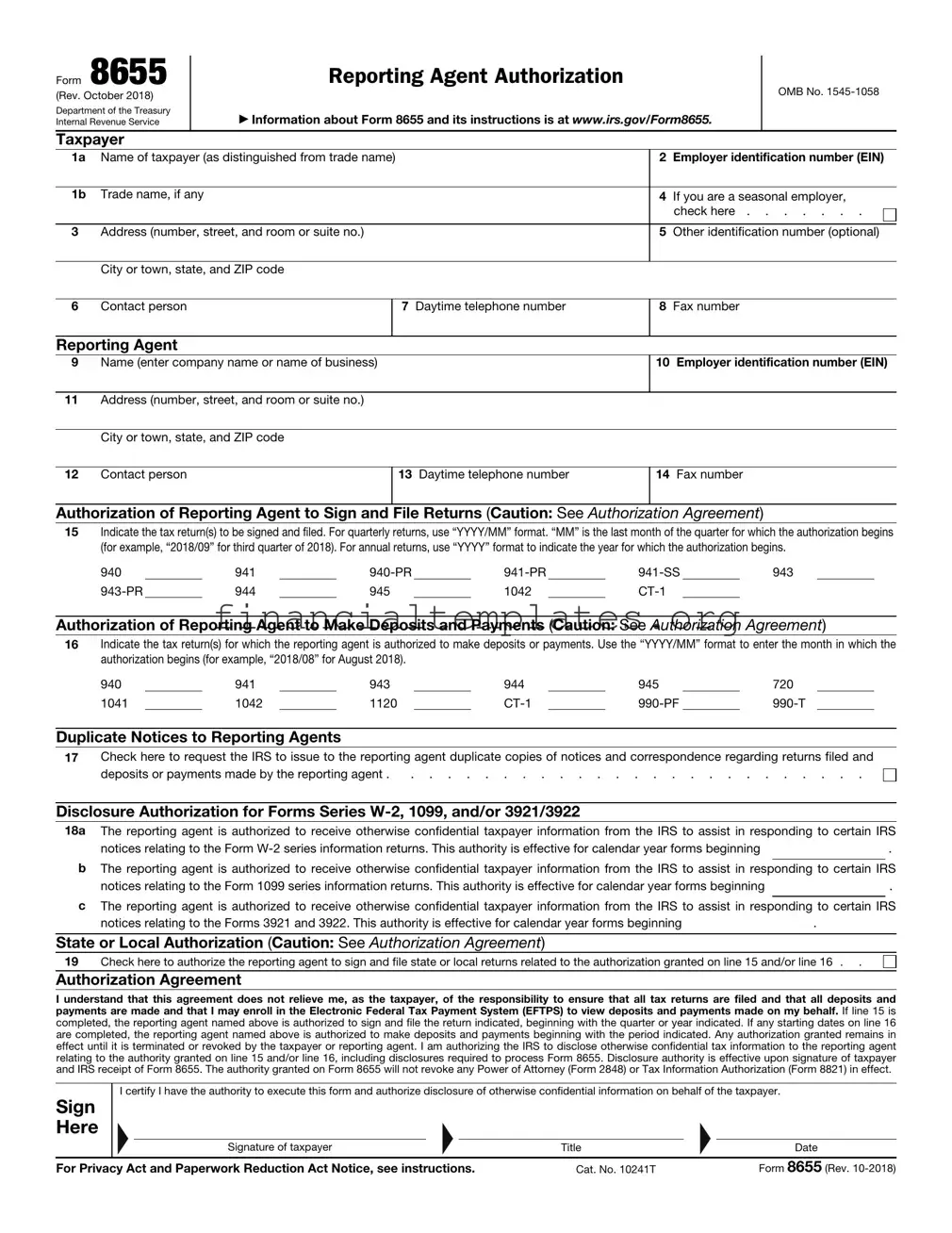Instructions
What’s New
Fax number. The fax number for Form 8655 is changed to 855-214-7523. When faxing Forms 8655, please send no more than 25 forms in a single transmission. If possible, please send faxes directly from your computer instead of from a fax machine.
Updated instructions for lines 15 and 16. The instructions for lines 15 and 16 have been clarified and now appear at the lines themselves. Please use the “YYYY/MM” format instead of the “MM/YYYY” format.
Former line 17a removed. The authorization agreement at the bottom of the form provides the disclosure authority previously covered by line 17a.
Increasing or decreasing authority. The instructions with regard to increasing or decreasing authority have been clarified. See Authority Granted.
Termination and Revocation. The instructions have been updated to distinguish between these terms and to explain the procedure for each. See Terminating or Revoking an Authorization.
Purpose of Form
Use Form 8655 to authorize a reporting agent to:
•Sign and file certain returns. Reporting agents must file returns electronically except as provided under Rev. Proc. 2012-32. You can find Rev. Proc. 2012-32 on page 267 of Internal Revenue Bulletin 2012-34 at www.irs.gov/pub/irs-irbs/irb12-34.pdf. See Pub. 3112, IRS e-file Application and Participation, for information about e-filing and getting the reporting agent PIN;
•Make deposits and payments for certain returns. Reporting agents must make deposits and payments electronically, generally through the Electronic Federal Tax Payment System (EFTPS.gov). See Pub. 4169, Tax Professional Guide to EFTPS, and Rev. Proc. 2012-33;
•Receive duplicate copies of tax information, notices, and other written and/ or electronic communication regarding any authority granted; and
•Provide IRS with information to aid in penalty relief determinations related to the authority granted on Form 8655.
Note. An authorization does not relieve the taxpayer of the responsibility (or from liability for failing) to ensure that all tax returns are filed timely and that all federal tax deposits (FTDs) and federal tax payments (FTPs) are made timely. A reporting agent must notify its client of that fact and must recommend that it enroll in the Electronic Federal Tax Payment System (EFTPS) to view EFTPS deposits and payments made on the client’s behalf. A reporting agent must provide this notification, in writing, upon entering into an agreement with the client and at least quarterly thereafter for as long as it provides services to that client. Sample language and other details may be found in Rev. Proc. 2012-32, Section 5.05.
Authority Granted
Once Form 8655 is signed, any authority granted is effective beginning with the period indicated on lines 15, 16, 18a, 18b, and/or 18c and continues indefinitely unless terminated or revoked by the taxpayer or reporting agent. No authorization or authority is granted for periods prior to the period(s) indicated on Form 8655.
Where authority is granted for any form, it is also effective for related forms such as the corresponding non-English language form, amended return, (Form 941-X, 941-X(PR), 943-X, 944-X, 945-X, or CT-1X), or payment voucher. For example, Form 8655 can be used to provide authorization for Form 944-SP using the entry spaces for Form 944. The form also can be used to authorize a reporting agent to make deposits and payments for other returns in the Form 1120 series, such as Form 1120-C, using the entry space for Form 1120 on line 16.
Disclosure authority is effective upon signature of taxpayer and IRS receipt of Form 8655. Any authority granted on Form 8655 does not revoke and has no effect on any authority granted on Forms 2848 or 8821, or any third-party designee checkbox authority.
To increase the authority granted to a reporting agent by a Form 8655 already in effect, submit another signed Form 8655, completing lines 1–14 and any line on which you want to add authority. To decrease the authority granted to a reporting agent by a Form 8655 already in effect, send a signed, written request to the address under Where To File. The preceding authorization remains in effect except as modified by the new one.
Where To File
Send Form 8655 to:
Internal Revenue Service
Accounts Management Service Center MS 6748 RAF Team
1973 North Rulon White Blvd. Ogden, UT 84404
You can fax Form 8655 to the IRS. The number is 855-214-7523. When faxing Forms 8655, please send no more than 25 forms in a single transmission. If possible, please send faxes from your computer instead of a fax machine.
Additional Information
Additional information concerning reporting agent authorizations may be found in:
•Pub. 1474, Technical Specifications Guide for Reporting Agent Authorization and Federal Tax Depositors.
•Rev. Proc. 2012-32.
Substitute Form 8655
If you want to prepare and use a substitute Form 8655, see Pub. 1167, General Rules and Specifications for Substitute Forms and Schedules. If your substitute Form 8655 is approved, the form approval number must be printed in the lower left margin of each substitute Form 8655 you file with the IRS.
Terminating or Revoking an Authorization
If you have a valid Form 8655 on file with the IRS, the filing of a new Form 8655 indicating a new reporting agent terminates the authority of the prior reporting agent beginning with the period indicated on the new Form 8655. However, the prior reporting agent is still an authorized reporting agent and retains any previously granted disclosure authority for the periods prior to the beginning period of the new reporting agent’s authorization unless specifically revoked.
If the taxpayer wants to revoke an existing authorization, such that the reporting agent would no longer be authorized to act or receive information for previously authorized tax periods, send a copy of the previously executed Form 8655 to the IRS at the address under Where To File, above. Re-sign the copy of the Form 8655 under the original signature. Write “REVOKE” across the top of the form. If you do not have a copy of the authorization you want to revoke, send a statement to the IRS. The statement of revocation must indicate that the authority of the reporting agent is revoked and must be signed by the taxpayer. Also, list the name and address of each reporting agent whose authority is revoked.
A reporting agent may terminate its authority by filing a statement with the IRS, either on paper or using a delete process. A reporting agent wanting to revoke its authority must submit the request in writing. The statement must be signed by the reporting agent (if filed on paper) and identify the name and address of the taxpayer and authorization(s) from which the reporting agent is withdrawing. For information on the delete process, see Pub. 1474.
Who Must Sign
Electronic signature. For guidance on optional electronic signature methods, including approved methods of authentication and signature and additional items that must appear on the Form 8655, see Pub. 1474, section 01.03.
Sole proprietorship. The individual owning the business.
Corporation (including a limited liability company (LLC) treated as a corporation). Generally, Form 8655 can be signed by: (a) an officer having legal authority to bind the corporation, (b) any person designated by the board of directors or other governing body, (c) any officer or employee on written request by any principal officer, and (d) any other person authorized to access information under section 6103(e).
Partnership (including an LLC treated as a partnership) or an unincorporated organization. Generally, Form 8655 can be signed by any person who was a member of the partnership during any part of the tax period covered by Form 8655.
Single member LLC treated as a disregarded entity. The owner of the LLC.
Trust or estate. The fiduciary.

